
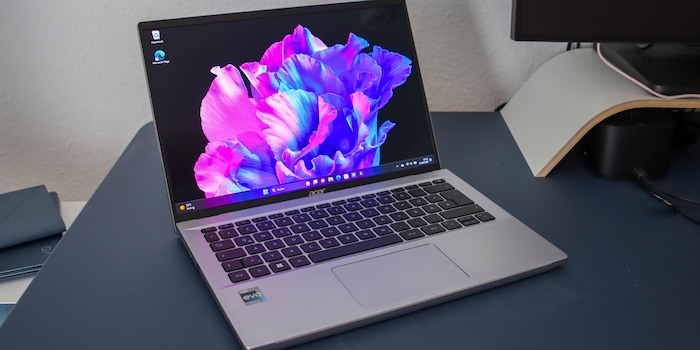
Acer Swift Go 14 review: my first OLED notebook
Notebooks with OLED displays are no longer an unaffordable luxury. And you won’t even have to sacrifice performance either, as Acer’s Swift 14 Go shows.
I’m used to OLED displays in smartphones. The Acer Swift Go 14, on the other hand, is the first notebook with an OLED screen that I’m taking a closer look at. Accordingly, I focus on the monitor in the test, still keeping all other features in mind.
Swiss keyboard

DE/AT keyboard (with OLED display, but currently only with AMD chipset)
Key specs:
- Display: 14-inch OLED, 2880 × 1800 pixels, 16:10, 60 hertz
- Processor: Intel Core i7-13700H
- Integrated graphics unit: Intel Iris Xe
- Working memory: 16 GB LPDDR5 RAM
- Data storage: 512 GB SSD
- Ports: USB 3.0 Type-A (2x), USB-C (2x), HDMI, Thunderbolt 4 (2x), 3.5 mm jack
- Webcam: 3.7 megapixels
- Wi-Fi, Bluetooth: Wi-Fi 6, Bluetooth 5.2
- Operating system: Windows 11 Home
- Battery: Lithium-ion, 65 Wh
- Power supply: 65 W
- Dimensions: 31.3 × 21.8 × 1.5 cm, 1.25 kg
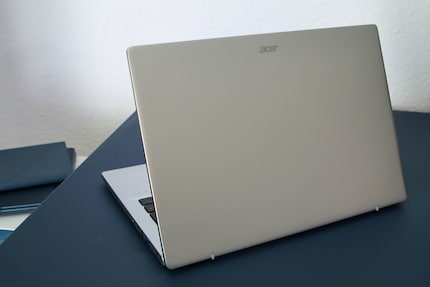
Source: Jan Johannsen
Beautiful display with one small catch
The Swift Go’s OLED display makes other notebooks with IPS displays look old in comparison. Colours shine bright without looking unnatural and black tones are really nice and dark. Even after a quick comparison with a work notebook, I only want an OLED screen.
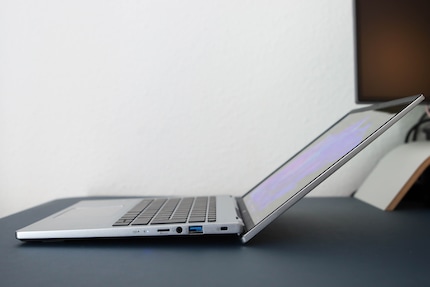
Source: Jan Johannsen
However, there’s one drawback: the Swift Go’s OLED display is reflective. This bothers me more than on smartphones. Their small displays move more when held and I constantly compensate for reflections without thinking about it. This isn’t as easy with a notebook, which usually stays in place while I work.
To back up the positive impression on first glance, I grab a measuring device.
100 per cent colour space coverage
First I measure the colour space coverage with DisplayCAL. Together with the Calibrite Colorchecker Display Plus, the software determines how well a display covers different colour spaces.
No matter what colour space you need, the OLED display covers it perfectly or near perfectly. For DCI P3 and sRGB, DisplayCAL measures a coverage of 100 per cent. With AdobeRGB, it’s 95.7 per cent. For comparison, my work laptop with its IPS display – an HP Elitebook 840 G9 – still achieves 99.1 per cent for sRGB. However, it only manages 79.2 per cent for DCI P3 and 76.9 per cent for AdobeRGB.
High brightness and uniform illumination
To measure the brightness and illumination of the screen, I again grab the Colorchecker Display Plus. However, this time I launch i1Profiler on the computer. This led to the following results:
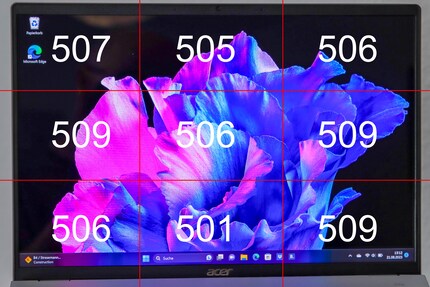
Source: Jan Johannsen
The illumination is very even. The biggest difference between the nine measuring fields is eight nits – virtually nothing.
To put these values into perspective, the luminosity of a display is considered good from 300 nits. It can be used in bright (sun) light from 400 nits, a hurdle the Swift Go easily clears.
The comparison with my work device shows that its IPS display is even brighter, but less evenly illuminated:
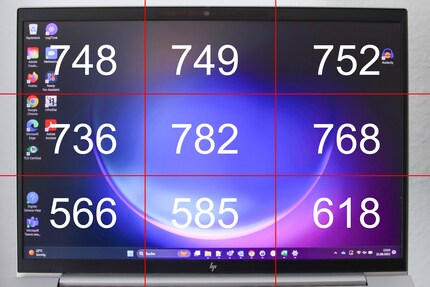
Source: Jan Johannsen
In the upper range, the uniformity of up to 46 nits is already worse than the Swift Go’s OLED. The bottom three values are way below average in comparison.
Acer’s OLED display achieves a rating of 0.55 for the Delta E value, which indicates how perceptible the colour difference is. It barely still falls into the range of «noticeable to the trained eye». The HP is already in the «perceived colour difference» category with 2.57 in the comparison.
Performance
With its hardware, the Swift Go 14 lends itself to more than just internet surfing and word processing. With the Intel Core i7-13700H, the integrated Iris Xe graphics chip and 16 gigabytes of RAM, image and video editing on a small scale is no problem. A dedicated graphics card is missing for large professional projects, same goes for games.
Again, I make a comparison with my work laptop, which contains the Core i7-1260P. It’s a generation older and performs a bit worse, but lets me get through my workday just fine – including some Lightroom and Photoshop.
The Intel Core i7-1355U in Lenovo’s current Yoga 9i performs considerably worse, stay tuned for a detailed test. But to classify things, it’s important to know that the U in the name indicates that the processor is particularly energy-efficient. P and H, on the other hand, stand for performance and high power.
Battery life
OLED displays are said to have a low power consumption, but this isn’t noticeable in the test. When playing a YouTube video at full brightness, the 65 Wh battery lasts 5:28 hours. Converted to watt hours per minute, the average value is 5.05 minutes. Looking at my last tests for comparison, the Matebook 16s only performs marginally better with 5.17 minutes. In contrast, the LG Gram 17 was much more efficient with 7.3 minutes.
Keyboard and touchpad
The backlit keyboard is decently average for a notebook. I find the short key drop and the clear pressure points pleasant. I like that the side arrow keys are large. On my work notebook, their top halves are taken up by Page Up and Page Down. I often hit them unintentionally, which bugs me. The fingerprint sensor in the power button is very practical and reliable.

Source: Jan Johannsen
The touchpad is comparatively small, but it was still enough for me. It responds reliably and has a clear pressure point when clicking.
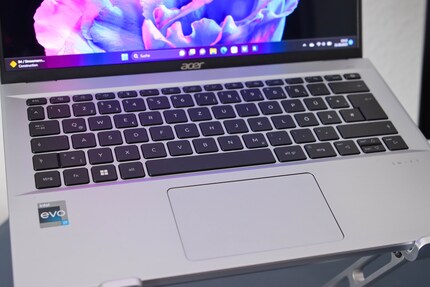
Source: Jan Johannsen
Ports
In terms of connectivity, the Acer Swift Go 14 is well positioned and should meet most demands. It has two USB-C and two USB-A ports. In addition, there’s an HDMI slot as well as a jack and a microSD card reader. Wirelessly, there’s Bluetooth 5.2 and Wi-Fi 6.
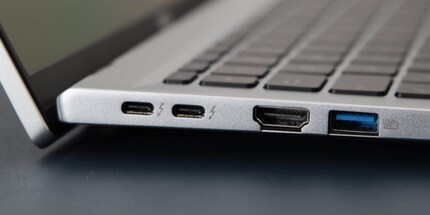
Source: Jan Johannsen
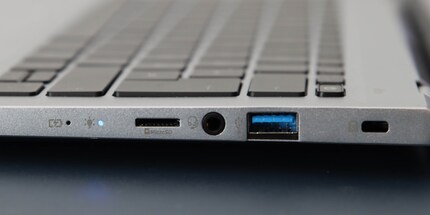
Source: Jan Johannsen
Verdict: I want more OLEDs
Even though the reflections bother me, I still only want to see OLED displays in notebooks in the future. Other screens will have a hard time winning me over completely. Even if I hardly need the high coverage of colour spaces. In addition, the OLED panels no longer make a laptop exorbitantly expensive.
Overall, the Acer Swift Go 14 satisfies me as a notebook. With the colour space coverage and the installed hardware, it even lends itself to graphics work as well as photo and video editing. However, only really for small projects. For large tasks, a graphics card in the computer would be useful.
The battery life is average, and the keyboard and touchpad are good. The connection ports are well set up, and in comparison with other notebooks sporting similar equipment, I don’t see a price premium down to the OLED display.
Header image: Jan Johannsen
As a primary school pupil, I used to sit in a friend's living room with many of my classmates to play the Super NES. Now I get my hands on the latest technology and test it for you. In recent years at Curved, Computer Bild and Netzwelt, now at Digitec and Galaxus.



